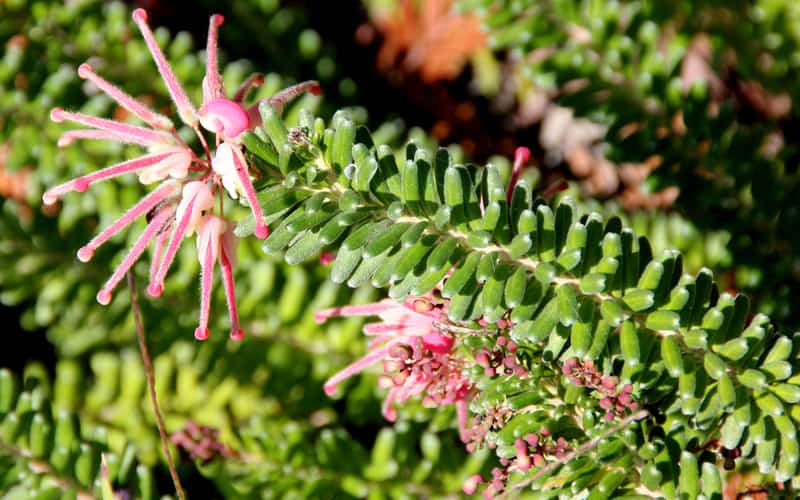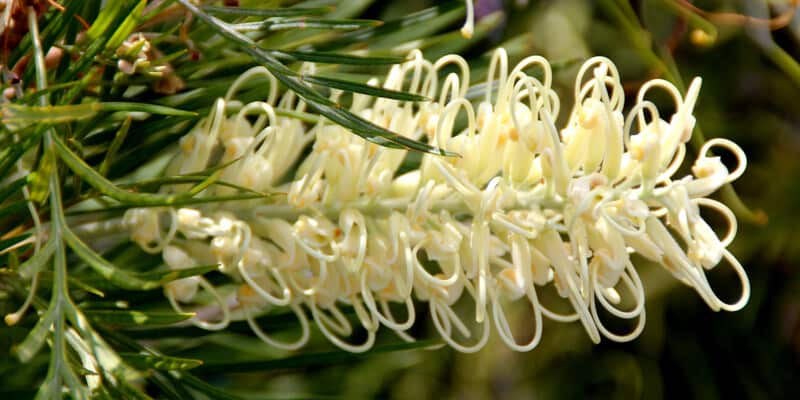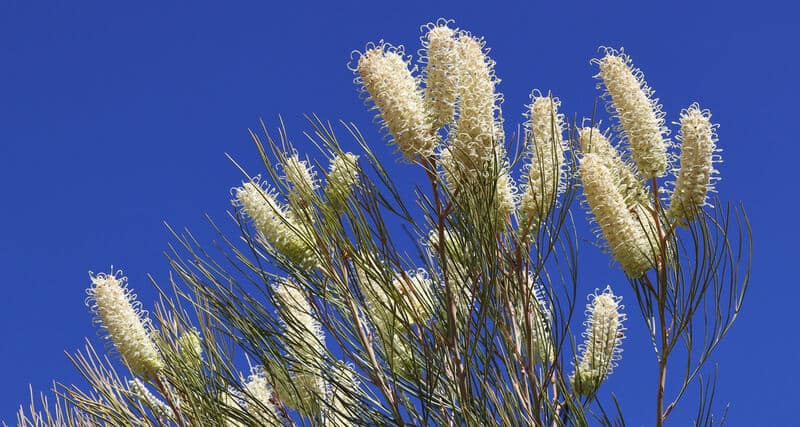Interested in native nature? Well, grevillea plants are some of your best choices. These Australian native garden plants range from small shrubs to large trees, with many varieties. They bloom for many months, producing striking pink and yellow flowers that resemble brushes. These flowers attract birds (such as honey-eating birds) and butterflies to your garden.
There are plenty of grevillea varieties, from ground cover to small shrubs to large trees. If you’re growing grevilleas, they need well drained soil – so consider planting them in a raised garden bed or elevated mounds. Make sure to use low-phosphorus fertilisers so you don’t shock the plant. The grevillea loves sun, so plant it somewhere in full sunlight, but sheltered from strong wind.
No matter the size of your garden, there’s a grevillea plant for you to grow. Here’s your complete guide to grevillea trees and flowers, from grevillea facts to plant care!
Grevillea Facts
The grevillea is a member of the Protea family (or the family Proteaceae), and is one of the most popular shrubs across Australia. It produces vivid flowers in a variety of colours, and comes in many forms and sizes. Its flower clusters can resemble one of three things: a toothbrush, a spider, or a brush. There are some 340 species, mostly endemic to Australia, with some in Papua New Guinea and other northern islands.
The grevillea takes its name from renowned botanist and Royal Horticultural Society founder, Charles Greville.
Grevillea plants are a close relative of the banksia, hakea, and waratah. Despite their flowers, though, don’t confuse them with the spider flower.
Grevillea flowers occur in clusters called an ‘inflorescence’ – a cluster of individual flowers. Peak blooming season is from winter into early spring, though they can flower at other times of the year. This makes them perfect for Australian gardens, since they add colour and spark no matter the season.
Also, before you plant a grevillea in your yard, make sure you’re not allergic – some people can react badly to their prickly leaves!
Grevillea Varieties
Most grevillea plants grow as small to medium shrubs, but some can grow as ground cover while others become tall trees. There’s a variety for all types of Australian gardens, alongside many other Australian native flowers and native trees. Here are some grevillea varieties to grow in your garden, no matter the size.
Grevillea ground cover
- Grevillea juniperina ‘H22’: This grevillea forms a dense, low mat with electric yellow-gold flowers. It only reaches 30cm in height, and can tolerate both drought and cold weather. Plant somewhere in full sun, although it can grow in partial shade. Grows particularly well in Southern Australia.
- Grevillea lanigera ‘Woolly Grevillea’: This is a fairly low-maintenance grevillea shrub that grows prostrate, although upright forms are available. It can spot-flower year round, but is most productive from winter to spring. It grows in sunny spots or semi-shade. When pruned, it stays at about half a metre in height. Plant in acidic, sandy soil.
- Grevillea ‘Pink Midget’: This grevillea is a spreading shrub that reaches only 30cm in height, and can spread to 1m across. It produces pink-purple flower clusters for an eye-catching display. The Pink Midget is excellent for smaller gardens, and can also be grown in pots.
Grevillea shrubs
- Grevillea ‘Peaches and Cream’: This variety of grevillea has distinctive pastel pink and orange flowers, which make it very popular for gardens. As a shrub, it grows up to 2m in height. Its green foliage turns bronze in the winter. ‘Peaches and Cream’ is reasonably frost tolerant. Prune the tips to encourage a ‘fluffy’ look.
- Grevillea ‘Long John’: This is one of the most popular grevilleas, with stunning coral blooms at the end of its upright branches. It’s easily grown in slightly acidic, free-draining soil, and is drought tolerant once mature. Prune after flowering to encourage better growth.
- Grevillea x ‘Canberra Gem’: This is a hybrid grevillea with narrow leaves and pinkish-red flowers. It grows very quickly, especially in moist soil in sunny conditions. This hybrid can reach 2.5m in height. It tolerates both frost and drought, and needs pruning to maintain its denseness.
Grevillea trees
- Grevillea robusta ‘Silky Oak’: The Silky Oak is known for its quality wood, which is frequently used in furniture. It’s very popular as an ornamental tree due to its stunning golden-orange flower clusters. It prefers slightly acidic and sandy soil, but can tolerate most soil conditions. This grevillea tree variety can reach a height of 10m, and 30m in the wild.
- Grevillea ‘Ivory Whip’: This grevillea can reach up to 6m in height, which makes it an ideal screen tree or hedge. (It also has a compact variety if you prefer smaller plants!) The Ivory Whip has a more uncommon colour, flowering in white clusters. It tolerates only light frost, and needs regular pruning to grow more densely.
- Grevillea ‘Moonlight’: This is a small to medium tree, reaching about 3-4m in height. It produces creamy white flowers throughout the year, especially if pruned properly. Plant in free-draining clay loams or sandy soils. The Moonlight grevillea tree will not tolerate anything more than a light frost.
Grevillea Growing Conditions
Soil
Grevilleas are native plants, so they’ve evolved to thrive in low-nutrient earth. Still, they need slightly acidic, well-drained soils to grow healthily. Consider a raised garden bed or elevated mound when planting, so that water drains away from the roots and prevents root rot.
Light
The grevillea grows best in plenty of sunlight, but will still grow in half sun or partial shade.
Climate
Frost tolerance differs between varieties, so check with your local nursery first before purchasing a shrub. Many grevilleas will grow in most climates, though – they’re a very hardy plant, especially once established!
How To Grow Grevillea
Grevilleas are more easily propagated from cuttings or seedlings instead of being grown from seeds. Check with your local nursery to see if they have grevillea starter plants that you can grow. Don’t go picking from wild grevilleas – you could damage the plant, and take away from its natural beauty.
Choose somewhere in your garden that gets full sun to half shade. Ensure the plant will be sheltered from any strong winds.
Dig a hole that’s twice as wide and just as deep as the root ball.
Gently remove the plant from its container, trying not to disturb the roots – they’re sensitive!
Position the plant in the hole and backfill, firming down the soil carefully.
Water well after planting, and keep the soil moist for the next several weeks. Be careful not to overwater, though – grevilleas don’t like wet feet.
You can also grow grevilleas in pots if you choose a dwarf or compact variety. Just ensure the pot sits somewhere sunny, and that it has drainage holes so your grevillea doesn’t retain water!
Grevillea Plant Care
Watering
Like most plants, grevilleas need regular watering while young. Mature plants are more drought tolerant and will only need extra watering during hot, dry months.
Pruning
You can lightly prune a grevillea tree after it flowers to encourage new growth and help maintain its shape. Potted grevilleas will require more regular pruning in order to maintain their size.
Fertilising
Grevilleas have proteoid roots – a root mass formed to take in nourishment from low-nutrient soil. Because of this, they’re especially sensitive to phosphorus, so use a specialised native fertiliser when feeding them. If you’re unsure of how to care for a grevillea or want an expert hand, consult a professional garden maintenance service on maintaining native plants.






